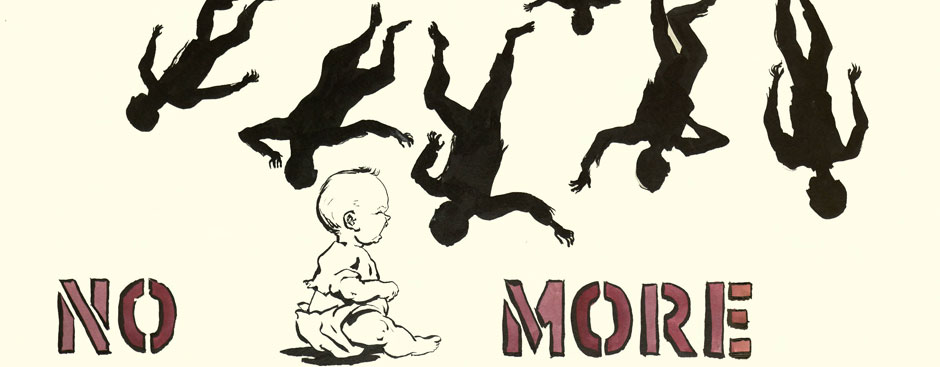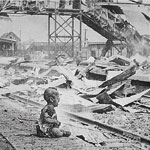No More Hiroshima's! Mr. Ford:
A Call Beyond National Boundaries
Xue Jin, Bryn Mawr College, Class of 2015
The homemade poster from the Swarthmore College Peace Collection depicts a nuclear mushroom cloud, silhouettes of bodies, a baby sitting among the slogan "NO MORE HIROSHIMA'S! MR. FORD," and portraits of President Truman and President Ford, the latter puffing out a mushroom cloud from his pipe. Although little is known about this poster, it offers a compelling visual statement on nuclear disasters.
The poster consists of two parts. The top section is powerfully direct with very simple yet iconic colors and shapes: a gray mushroom cloud painted in free and expressive brushwork set off by dark sky, and a cluster of black silhouettes representing dead bodies. One can immediately recognizes the subject matter of atomic bombing from the explicit representation as well as the heavy and depressive atmosphere created. That the mushroom cloud and human silhouettes are mirrored in shape and inverse in color makes a visually strong statement that nuclear weapons and human life cannot coexist. Both as results from atomic bombing, the mushroom cloud and falling bodies visually associated with each other, suggesting that the lethality of such dominant power is directly related to the extent of death it causes, and that its existence wipes off the hope of survival.
The bottom section, which consists of the slogan, the baby, and portraits of two American Presidents, invites historical unpacking. The crying baby, a sign of new life, contrasts with the dead bodies, implying that the appeal for "No More Hiroshimas" is for the benefit of future generations. Besides, the baby is visually similar with another infant image in a famous wartime photograph Bloody Saturday (Figure 1). Though controversial, there is a belief that the baby captured in the photograph was probably the only human being left alive after a fire bombing ("WWII: A just war or just a war? | DocsTeach: Activities," n.d.). Thus, such similarity appearing in this poster, if made intentionally, creates a dialogue across time and carries the message that war in general leaves little hope for the future.
The portraits of the two Presidents in the lower right corner of the poster are accompanied by their names, and when up close, one can see printed words showing through the paper, demonstrating that these are in fact clippings from a publication (Figure 2). Although the poster's creator, date, and purpose remain unknown, information on the donor and historical context offer viewers clues toward the possible function and implications of the poster.
According to Wendy E. Chmielewski, curator of Swarthmore College Peace Collection, the poster was a gift of Kay Camp (Swarthmore College Class of 1940) along with her papers. A self-described "peace protagonist," Mrs. Camp devoted 50 years to the Women's International League for Peace and Freedom. During World War II, she worked as a cryptographer for the War Department in Washington. In 1978, she became an adviser to the U.S delegation to the U.N. Special Session on Disarmament. She was a significant anti-nuclear advocate. In 1980, she spent four days in jail for protesting the nuclear power plant at Limerick, and she led a chapter protest against nuclear weapons outside the Bryn Mawr post office in 1996, on the anniversary of the bombing of Nagasaki, with the ambition of abolishing all nuclear weapons by 2000 ("Kay Camp Papers (DG 169), Swarthmore College Peace Collection," 2009). Her influence on peace and anti-nuclear movements has continued with paper donations to Swarthmore College Peace Collection, including objects like a bookmark with paper flowers, paper doll accompanied by the text "No more Hiroshima. No more Nagasaki. We should rid the Earth of all nuclear weapons for our children. New Japan Women's Association, Kyoto" (in English and Japanese), as well as this homemade poster.
Based on Kay Camp's involvement in anti-nuclear movements, this poster was most likely made for one of the demonstrations she participated in between 1974 and 1977 when President Ford was in office as the 38th President of the United States. During President Ford's tenure, there was a rising opposition among Japanese press aroused by Colonel Paul Tibbets, the pilot of the Enola Gay from which the bomb dropped on Hiroshima. In October 1976, a group named the Confederate Air Force organized an air show in Texas, during which Tibbets "flew the last air-worthy B-29 bomber and simulated the dropping of the mock atomic bomb, as eighteen thousand spectators looked on" (Asada, 2007, p. 221). The Japanese quickly denounced such behavior. The mayors of Hiroshima and Nagasaki, the Foreign Ministry, and hibakusha (surviving victims of atomic bombings) associations telegraphed President Ford, asking for apologies from the sponsors of the air show (Asada, 2007, p. 222). President Ford's direct reaction was unclear, but the sponsors in Texas refused to apologize and justified the bombings in Hiroshima and Nagasaki. Furthermore, in the following year, they organized another air show including a similar mock bomb. This time its sponsors was demanded to cancel it, "for fear of adversely influencing relations with the allied nation," under the pressure from the Congress, the State Department, and the Defense Department (Asada, 2007, p. 221-222). The sponsors gave in, but Tibbets still flew the B-29 during the show.
President Ford declined comment on this direct confrontation, and appeared to have a conservative attitude from the beginning of his term. While till now no American president has ever visited Hiroshima, according to research conducted by Asahi Shimbun, a major national newspaper in Japan, and the Investigative Reporting Workshop at American University, in 1974 a senior advisor William J. Baroody Jr. urged President Ford to visit Hiroshima. The visit was proposed as "part of the first presidential trip ever to Japan", which would include "a speech about peace and reconciliation" as a sincere effort to heal wounds (Okuyama, 2010). However, the proposal was overruled by other White House officials.
Fueled by the rising tension among American governmental officials and the Japanese public opinion, and President Ford's reluctance to address issues caused by Atomic Bombing in Hiroshima, the anti-nuclear sentiment of the poster likely targets the President in term. By drawing a connection between President Truman and President Ford, it suggests that the President in term had equal responsibility for Hiroshima's bombing. Another parallel between the mushroom cloud of the bombing and that coming out from President Ford's pipe indicates a call against further potential disasters caused by nuclear weapons and a strong implication that reticence is connivance.


